The best way to lose belly fat is to combine a calorie-controlled, high-protein diet with regular cardio and strength training, while limiting processed foods and managing stress. According to medical and nutrition experts, there’s no magic trick to shrinking your waistline—only a strategic, sustainable approach that targets overall body fat.
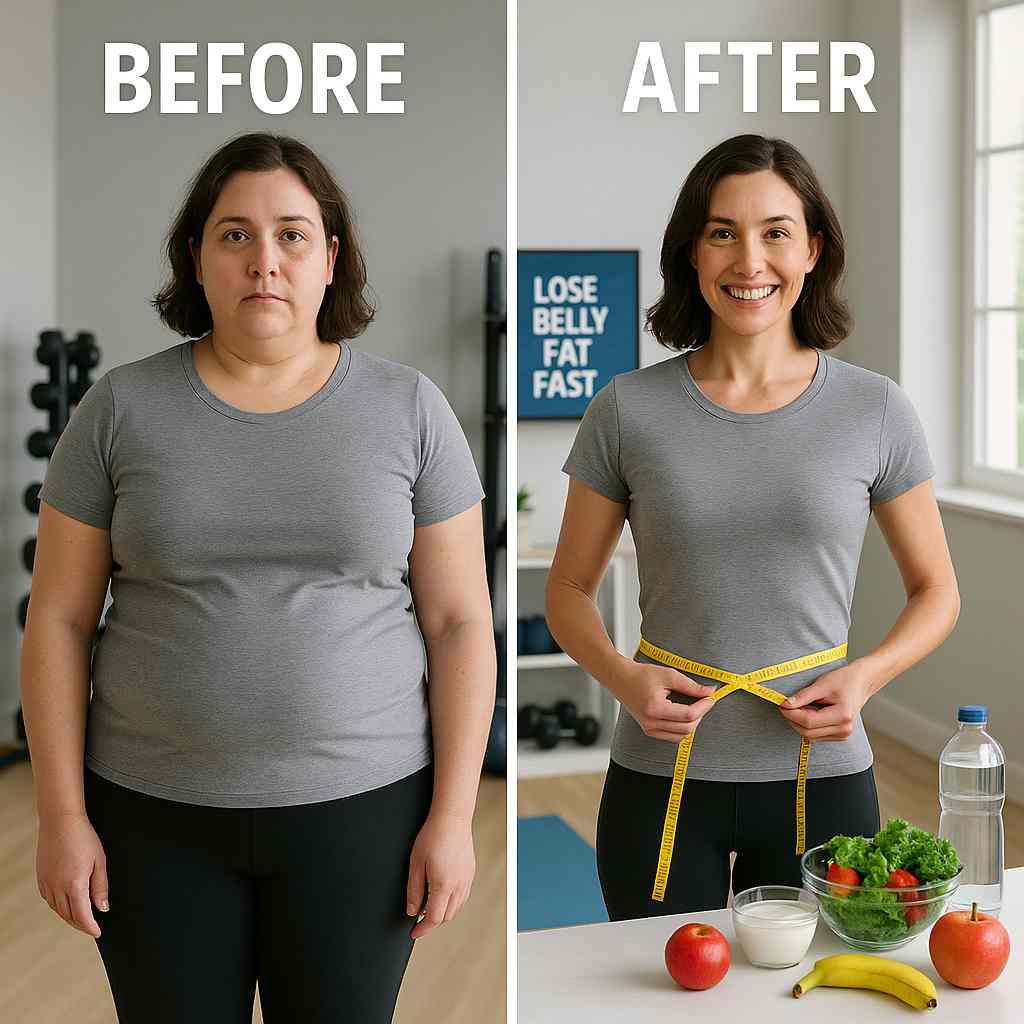
Understanding how to lose belly fat is crucial for long-term health. Visceral fat (the fat deep inside your abdomen) increases the risk of heart disease, type 2 diabetes, high blood pressure, and certain cancers. The good news? Research shows you can dramatically reduce abdominal fat with evidence-based lifestyle changes—even if you’ve struggled before.
This detailed guide will walk you through the 16 best, proven ways to lose belly fat, with references to trusted sources like Harvard Health, Johns Hopkins Medicine, and more. Let’s get started!
Why Losing Belly Fat Matters: Health Risks of Visceral Fat
Losing belly fat is about more than just looking fit—it’s crucial for your long-term health. Visceral fat, which is the deep abdominal fat that surrounds your organs, is linked to some of the most serious health risks. Unlike the fat you can pinch under your skin, visceral fat is hidden and highly active in your body’s metabolism.
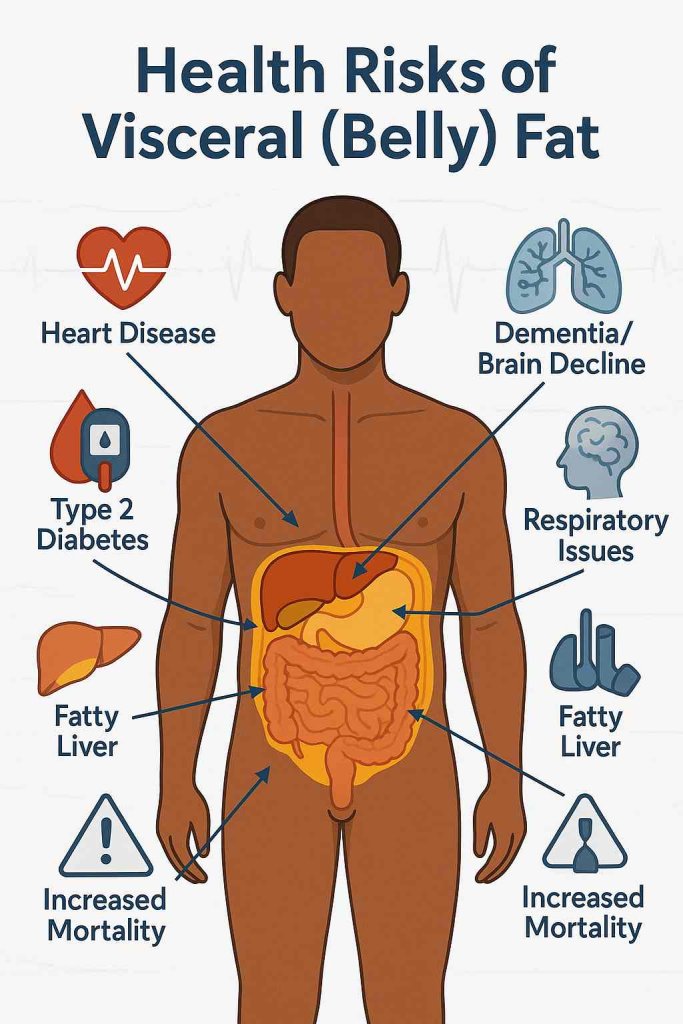
Key Health Risks of Visceral Fat
- Heart Disease and Stroke: Visceral fat releases inflammatory substances and hormones that raise blood pressure and cholesterol. This dramatically increases your risk of heart attack, stroke, and other cardiovascular diseases—even if you appear slim elsewhere on your body. Studies show people with excess belly fat are at much higher risk, regardless of their BMI (Harvard Health, Heart.org).
- Type 2 Diabetes and Insulin Resistance: Deep belly fat interferes with how your body processes insulin, increasing your chances of insulin resistance and type 2 diabetes (WebMD).
- Certain Cancers: High visceral fat is strongly linked to increased risk of cancers such as colorectal, breast, and pancreatic cancer (Harvard Health).
- Cognitive Decline: Research finds a strong association between belly fat and a higher risk of dementia and Alzheimer’s disease. People with more visceral fat often have smaller brain volumes and poorer memory later in life (The Australian).
- Respiratory Problems: Belly fat can increase your risk of asthma and sleep apnea, as it restricts your lungs and affects breathing patterns.
- Fatty Liver Disease: Visceral fat is a major cause of nonalcoholic fatty liver disease, which can lead to liver damage over time.
- All-Cause Mortality: Research shows that a higher waist circumference (even with a normal weight) is a much stronger predictor of early death than BMI alone (The Times UK).
Why This Fat Is So Dangerous
Visceral fat isn’t just “stored energy.” It actively releases hormones and inflammatory chemicals into your bloodstream, disrupting how your body manages blood sugar, cholesterol, and blood pressure. This chronic inflammation and hormonal imbalance is what makes belly fat particularly risky.
Measuring your waist (over 40 inches/102 cm for men and 35 inches/88 cm for women) is one of the best ways to gauge your visceral fat risk—even more so than the scale.
16 Evidence-Based Ways to Lose Belly Fat (Backed by Science & Research)
1. Create a Calorie Deficit: The Foundation of All Fat Loss
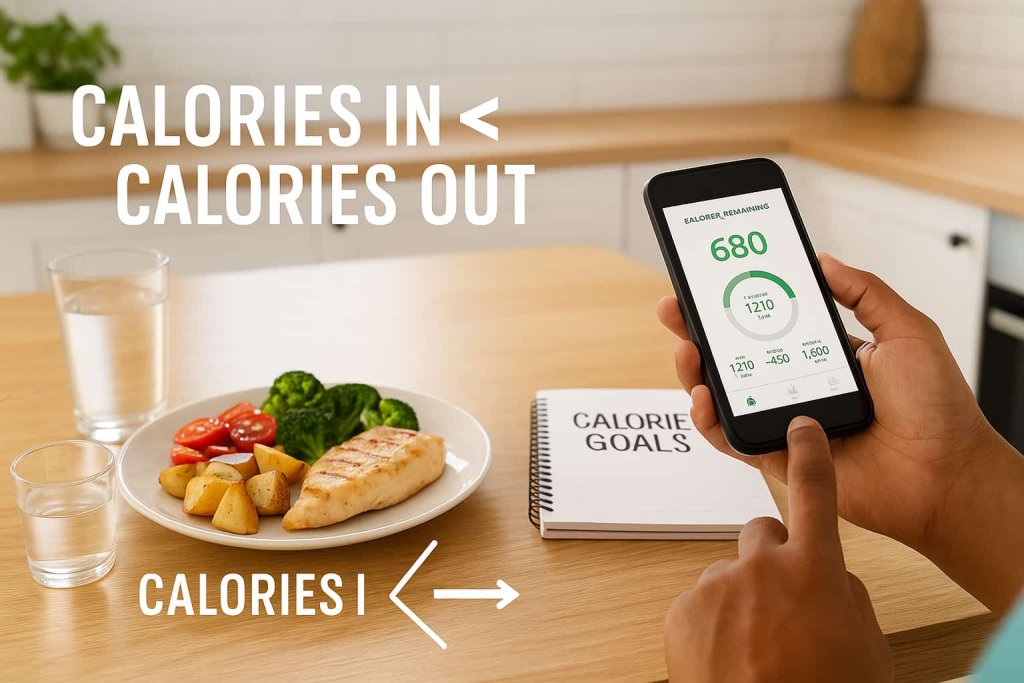
Evidence-based: Multiple studies confirm that a consistent calorie deficit is essential for losing belly fat. When you burn more calories than you consume, your body is forced to use stored fat for energy—including stubborn abdominal fat.
- How to do it:
- Use tracking apps like MyFitnessPal or Cronometer to monitor your daily intake.
- Focus on portion control and avoid calorie-rich drinks.
- Aim for a daily deficit of 300–500 calories, which typically leads to a safe loss of 0.5–1 kg (1–2 lbs) per week.
- Science: The Centers for Disease Control and Prevention (CDC) states that reducing your daily calories by 500 can result in about 1 pound of weight loss per week, mostly from fat stores. CDC – Healthy Weight Loss
2. Do Regular Cardio Exercise

Evidence-based: Aerobic exercise specifically targets visceral (deep belly) fat and reduces waist circumference—even if total weight doesn’t change much.
- How to do it:
- Aim for at least 150 minutes of moderate-intensity cardio (brisk walking, cycling) or 75 minutes of vigorous cardio (HIIT, running) per week.
- Mix different forms of cardio for best results.
- Science: Harvard Health found that brisk walking for 30 minutes, five days a week, leads to significantly more belly fat loss than inactivity. Harvard Health – Why Belly Fat Is So Hard to Lose
3. Add High-Intensity Interval Training (HIIT)
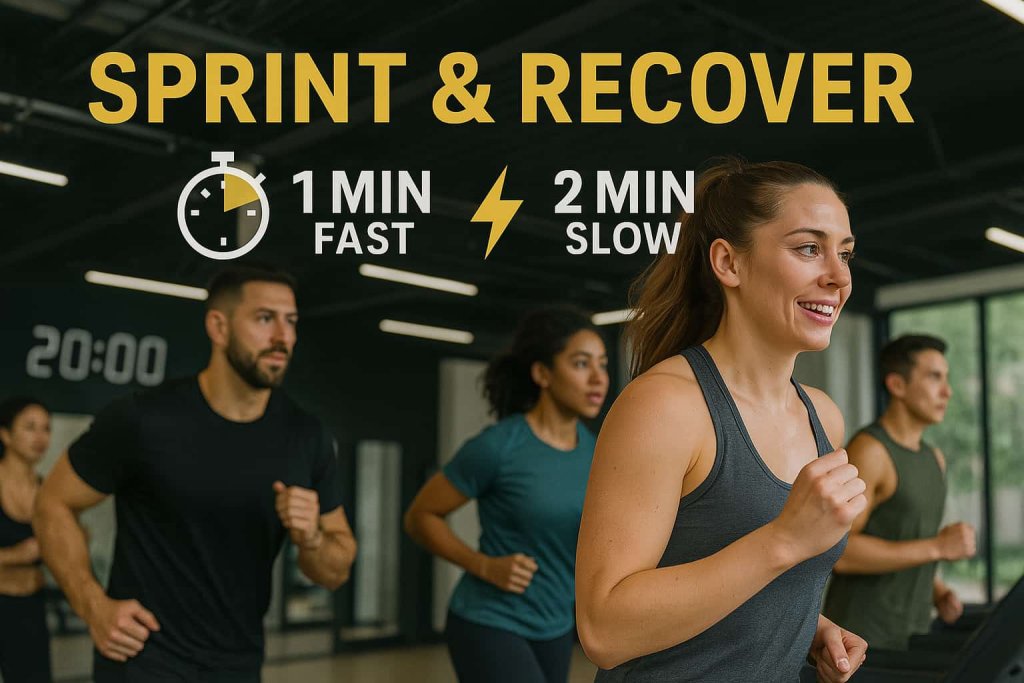
Evidence-based: HIIT—short bursts of intense activity alternated with recovery—has been shown to burn belly fat more effectively than steady-state cardio.
- How to do it:
- Try HIIT 2–3 times per week for 20–30 minutes per session.
- A simple protocol: 1 minute sprint + 2 minutes recovery, repeated for 20 minutes.
- Science: A systematic review and meta-analysis published in Obesity Reviews found that high-intensity interval training (HIIT) reduces abdominal fat—including visceral fat—as efficiently as moderate-intensity cardio, but in less time. HIIT is a time-saving and effective approach for both men and women aiming to reduce belly fat.
4. Incorporate Strength Training
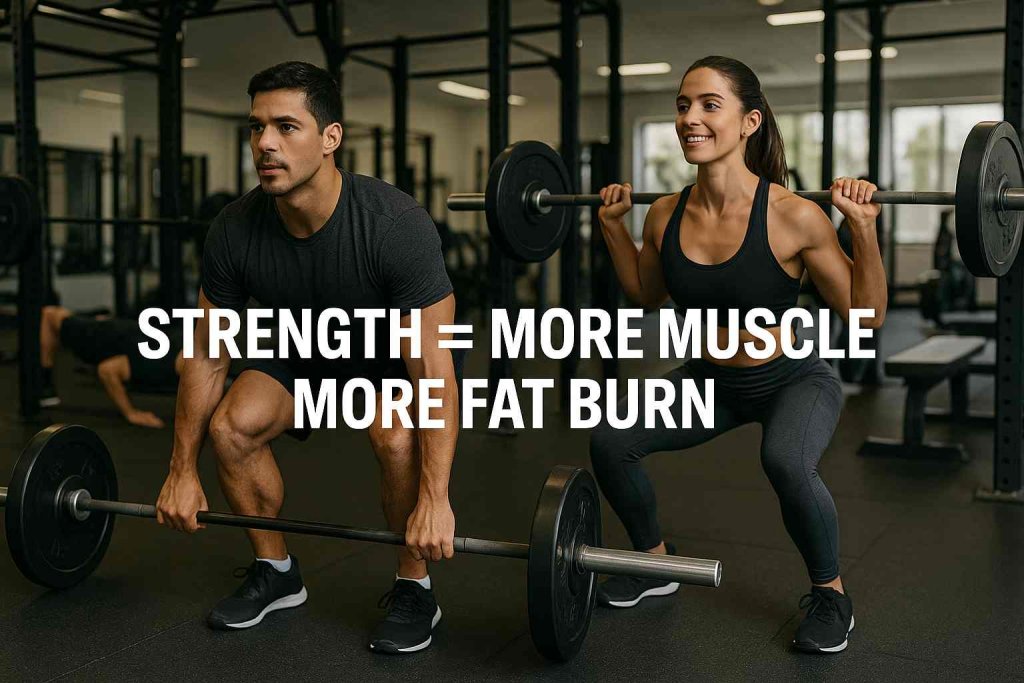
Evidence-based: Resistance training builds muscle, which increases your resting metabolic rate and helps burn more fat—even at rest.
- How to do it:
- Train all major muscle groups at least twice a week using free weights, machines, or bodyweight.
- Focus on compound exercises: squats, deadlifts, presses, and rows.
- Science: According to Johns Hopkins Medicine, combining strength and aerobic exercise leads to more visceral fat loss than either alone. Johns Hopkins Medicine – Strength Training
5. Eat More Soluble Fiber

Evidence-based: Soluble fiber helps slow digestion, increase fullness, stabilize blood sugar, and decrease belly fat gain.
- How to do it:
- Include more oats, beans, lentils, apples, pears, avocados, and flaxseed in your diet.
- Aim for at least 25g of fiber per day for women and 30g for men.
- Science: Wake Forest research found that every 10g increase in soluble fiber reduced visceral fat by 3.7% over five years. Wake Forest – Soluble Fiber Study
6. Focus on Plant-Based Foods
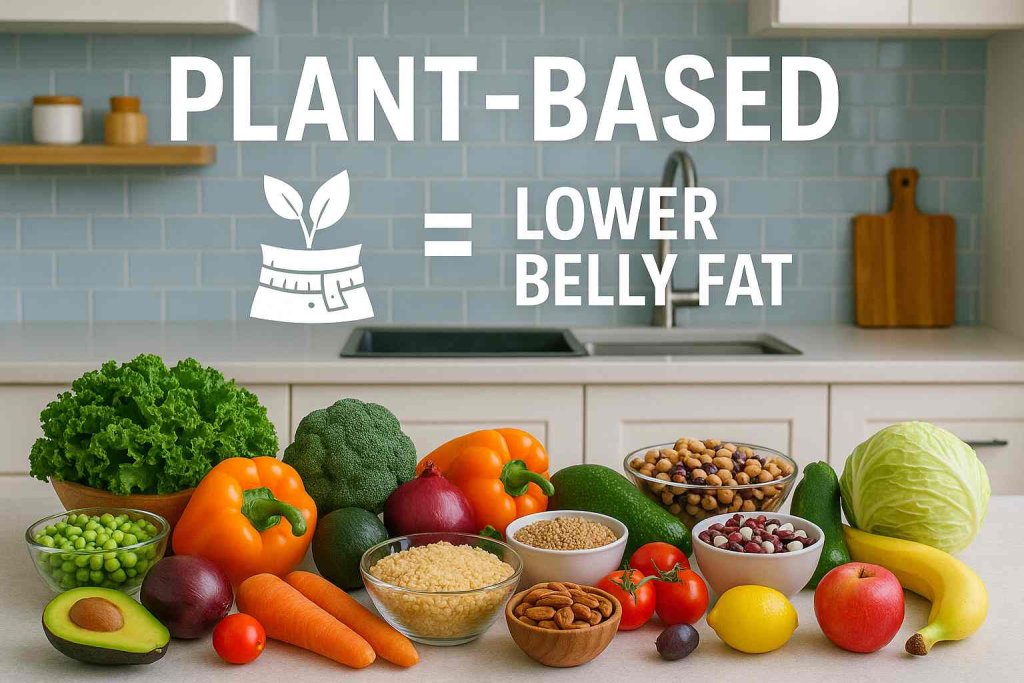
Evidence-based: Diets high in whole plant foods (vegetables, fruits, grains, legumes, nuts, seeds) are linked to a lower waist circumference and less visceral fat.
- How to do it:
- Make half your plate vegetables at every meal.
- Prioritize whole grains, beans, and healthy fats from nuts and seeds.
- Science: Expert reviews and multiple research studies show that eating more plant-based meals—filled with vegetables, fruits, whole grains, beans, nuts, and seeds—is consistently linked with a smaller waistline and less belly fat.
7. Prioritize Protein at Every Meal
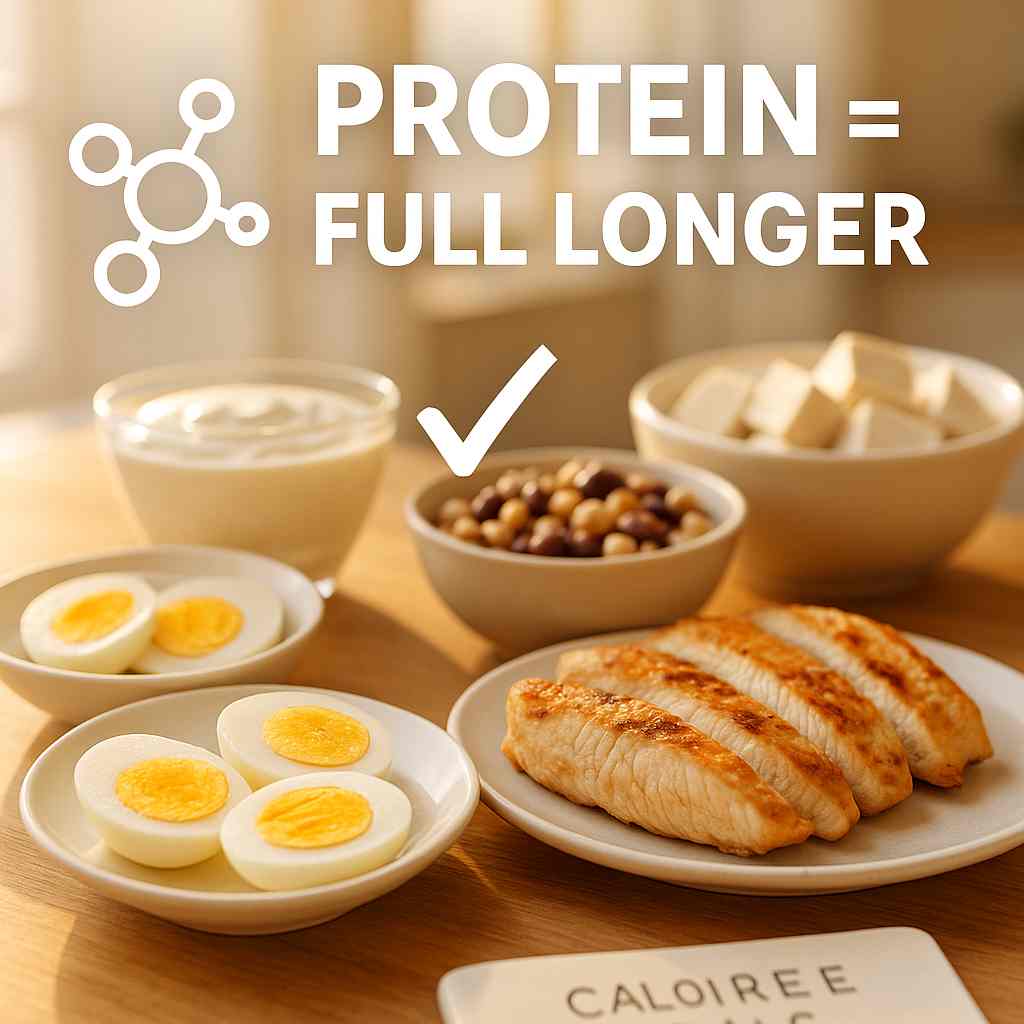
Evidence-based: Higher protein intake increases satiety, preserves muscle, and boosts metabolism, helping to burn more calories—even while resting.
- How to do it:
- Include protein sources like eggs, poultry, fish, Greek yogurt, tofu, or legumes at every meal.
- Aim for 25–35% of daily calories from protein.
- Science: Research shows that high-protein diets lead to less hunger, fewer cravings, and greater belly fat loss during weight loss phases. Healthline – High-Protein Diet Benefits
8. Avoid Trans Fats and Ultra-Processed Foods
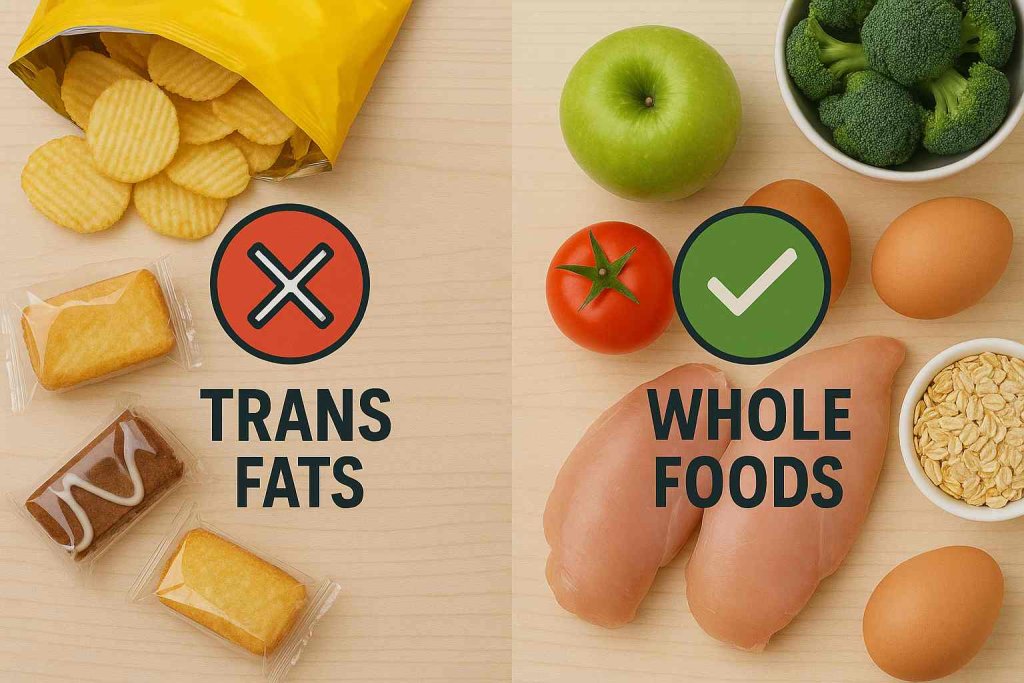
Evidence-based: Trans fats and ultra-processed foods increase inflammation and promote visceral (abdominal) fat accumulation.
- How to do it:
- Check ingredient labels for “partially hydrogenated oils.”
- Limit packaged snacks, processed meats, fast food, and ready-to-eat meals.
- Science: A 2024 umbrella review published in The BMJ found that people who eat more ultra-processed foods are at significantly greater risk of abdominal obesity and a larger waist circumference. Those with the highest UPF intake had about 41–49% higher odds of developing belly fat than those who ate the least, regardless of total calories or other lifestyle factors.
9. Cut Down on Added Sugar
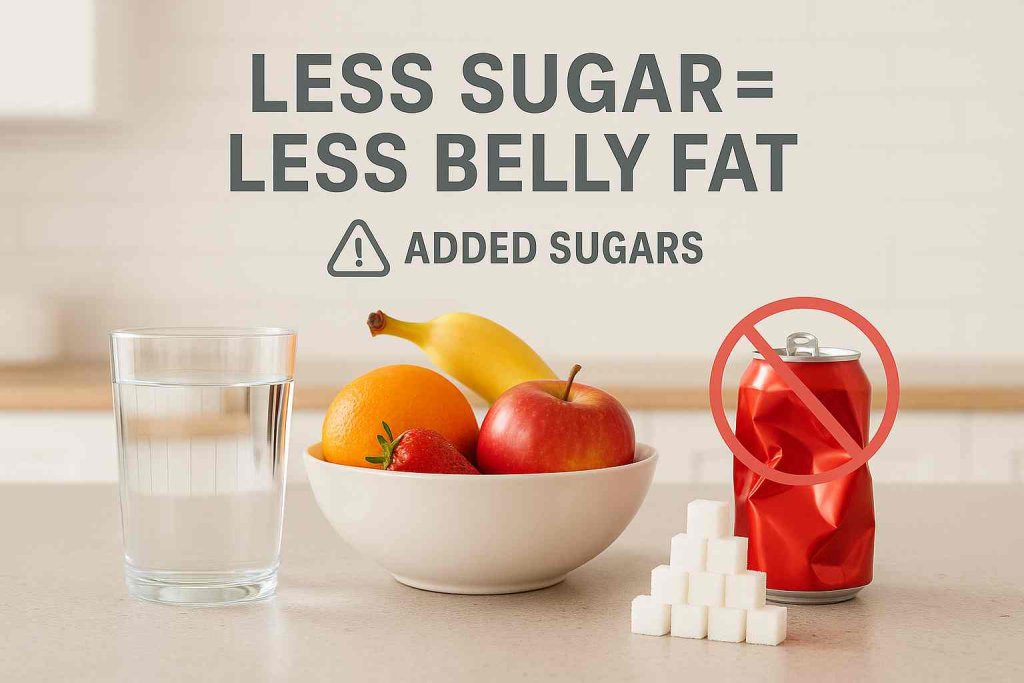
Evidence-based: Added sugar, especially in drinks and desserts, is a major driver of belly fat and metabolic syndrome.
- How to do it:
- Replace sugary drinks with water or unsweetened beverages.
- Use fruit to satisfy sweet cravings.
- Science: The Mayo Clinic confirms that cutting back on added sugars—especially from sugary drinks and processed foods—can help reduce belly fat. Excess sugar is directly linked to increased abdominal fat and higher metabolic risk.
10. Limit Alcohol

Evidence-based: Alcohol, especially beer and sugary cocktails, is strongly associated with increased abdominal fat.
- How to do it:
- Limit to 1 drink per day (women), 2 (men).
- Choose lower-calorie drinks like dry wine or spirits with sparkling water.
- Science: A 2024 meta-analysis found people who drink less alcohol have significantly smaller waistlines. Obesity Reviews – Alcohol and Abdominal Obesity
11. Manage Stress Effectively

Evidence-based: Chronic stress raises cortisol, which can promote fat storage in your midsection.
- How to do it:
- Use stress management tools such as deep breathing, meditation, mindfulness, or yoga.
- Build a healthy support network and make time for relaxation.
- Science: The American Psychological Association recognizes that stress management is key for successful, lasting weight loss. APA – Stress and Weight Gain
12. Get Enough Quality Sleep

Evidence-based: Poor sleep disrupts hunger hormones, slows metabolism, and increases the risk of visceral fat gain.
- How to do it:
- Aim for 7–8 hours of restful sleep per night.
- Keep your bedtime and wake-up time consistent.
- Science: A controlled study by Mayo Clinic (2022) found that sleep-restricted healthy adults experienced a 9% increase in total abdominal fat and an 11% increase in visceral fat, even without significant weight gain. The Cleveland Clinic also notes that insufficient sleep may raise the risk of accumulating visceral fat, and recommends at least seven hours per night.
13. Try Intermittent Fasting or Meal Timing
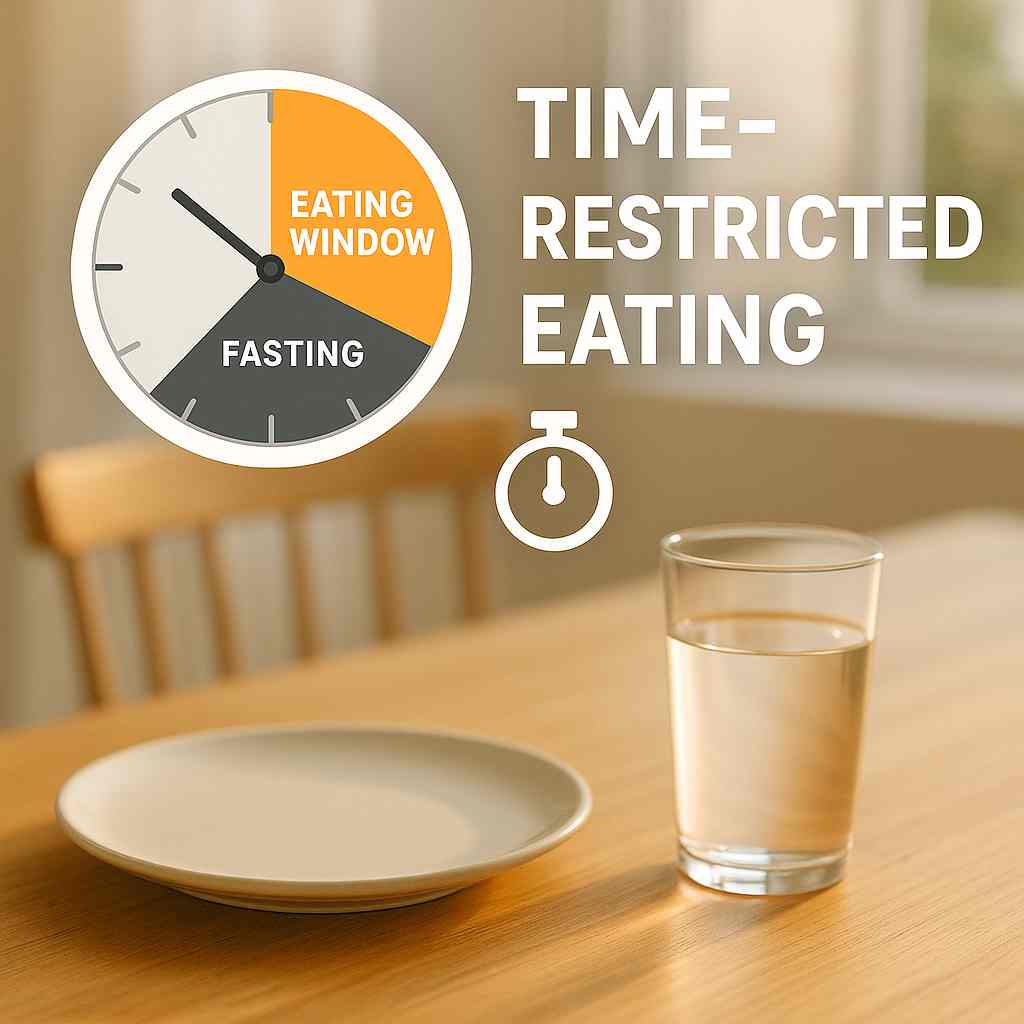
Evidence-based: Intermittent fasting (e.g., 16:8, 14:10) and avoiding late-night eating can help burn more fat and improve insulin sensitivity.
- How to do it:
- Try time-restricted eating (e.g., 12–16 hour fasting window).
- Avoid eating late at night.
- Science: Recent clinical trials show time-restricted eating supports greater belly fat loss and improved blood sugar control. JAMA Network – Intermittent Fasting Trials
14. Track Food and Activity
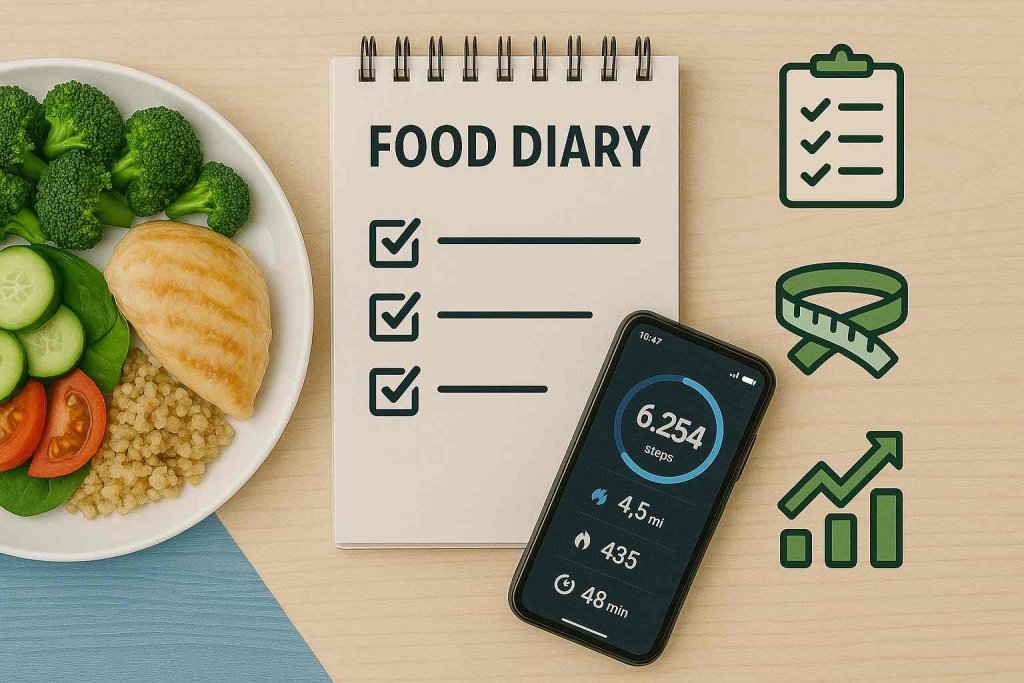
Evidence-based: People who keep food journals or use tracking apps lose up to twice as much weight as those who don’t track.
- How to do it:
- Log your meals, snacks, and workouts daily.
- Use weekly waist measurements and photos to track progress.
- Science: Self-monitoring is associated with better weight loss outcomes, according to a 2024 Obesity study. Obesity – Self-Monitoring Improves Weight Loss
15. Drink Plenty of Water

Evidence-based: Drinking water helps control appetite, supports metabolism, and can boost calorie burning, especially when consumed before meals.
- How to do it:
- Aim for at least 2 liters (8 cups) per day.
- Drink a glass 20–30 minutes before each meal.
- Science: A study in Obesity found people who drank 500ml (about 17oz) before meals lost 44% more weight than those who didn’t. Obesity – Water and Weight Loss
16. Consider Green Tea or Coffee

Evidence-based: Green tea (rich in catechins) and coffee (caffeine) both increase energy expenditure and fat burning, especially with regular exercise.
- How to do it:
- Replace sugary lattes with unsweetened coffee or green tea.
- Limit caffeine to 400mg/day (about 4 cups of coffee).
- Science: NIH research shows green tea extract can increase fat burning by 10–17%, particularly when combined with regular exercise. NIH – Green Tea for Fat Loss
Example Daily Plan to Lose Belly Fat
| Time | What to Do/Eat |
|---|---|
| Morning | High-protein breakfast (eggs, yogurt, fruit) + water |
| Mid-morning | 10–20 min walk outside, stretch, drink water |
| Lunch | Grilled chicken/fish + salad + quinoa or brown rice |
| Afternoon | Snack: carrot sticks with hummus or apple with nut butter |
| Evening | Strength or HIIT session (30–40 min) or brisk walk (30–60 min) |
| Dinner | Salmon or tofu + steamed veggies + olive oil drizzle |
| Before bed | Herbal tea, dim lights, relax for better sleep |
Frequently Asked Questions
How fast can I lose belly fat?
Expect 1–2 lbs of total fat loss per week with a healthy approach. Waist circumference may decrease in 4–8 weeks.
Do “fat burner” pills work?
There is little evidence for most fat burner supplements. Focus on proven lifestyle habits.
Why is belly fat so stubborn?
Visceral fat is hormonally active and tends to be the last to go. Persistence with a full lifestyle approach is key.
Conclusion
Belly fat loss is achievable—when you combine evidence-based strategies that work. Focus on a calorie deficit, move regularly, build muscle, prioritize whole foods, manage stress, and make sleep a priority. The most effective results come from a combination of small, sustainable changes over time.
